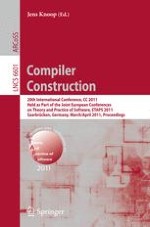2011 | Buch
Compiler Construction
20th International Conference, CC 2011, Held as Part of the Joint European Conferences on Theory and Practice of Software, ETAPS 2011, Saarbrücken, Germany, March 26–April 3, 2011. Proceedings
herausgegeben von: Jens Knoop
Verlag: Springer Berlin Heidelberg
Buchreihe : Lecture Notes in Computer Science
